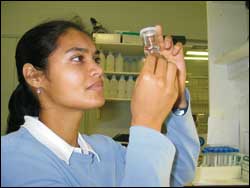What's your poison?
15 May 2006
Behind glass: Michelle van der Ventel tackles the results of her mouse model of fish allergy, especially parvalbumin, a fish-muscle calcium-binding protein.
Master's student Michelle van der Ventel used to be partial to a piece of fresh snoek. These days she's seen too much under the microscope to really enjoy the Cape delicacy. Things like Anisakis pergreffii, a nematode or parasitic worm that lives in the intestines of fish.
The David and Elaine Potter fellow's research into food allergens reveals the importance of fish allergy. During her honours research project, Van der Ventel investigated Anisakis infection and its influence on the allergic response to common food allergens (pass on the sushi).
"Food allergies are characterised as an adverse or abnormal host response to a particular molecule present in food. This reaction triggers the body's immune system to elicit 'IgE' antibodies that bind to special mast cells. On binding, these mast cells are activated and release chemical mediators which, in turn, cause the symptoms associated with an allergic response."
As part of her commitments towards her sponsors, she recently hosted a seminar on food allergies, gathering representatives of the food industry and consumer markets so that health professionals in the field may inform them about food allergy, occupational sensitisation, self-prevention and control strategies.
"The primary predisposing factor leading to allergies is sensitisation," Van der Ventel said. "Once sensitised, the individual will continue to mount an allergic immune response to the specific allergen." Key symptoms range from watery eyes to life-threatening reactions, including respiratory disease and anaphylactic shock.
Basic eatables and drinkables like milk, eggs, peanuts and fish, which constitute an important protein source in Africa, are responsible for about 90% of allergic reactions. It's a growing worldwide problem. In South Africa, 6% of children and 4% of adults are allergic to different kinds of food.
"The prevalence of fish allergy is on the increase and forms a particularly troublesome condition. Allergic diseases such as asthma, hay fever, eczema and food allergies are among the most common - and costly - diseases in the world."
True food allergies, says Van der Ventel, now in the second year of her master's, should not be confused with other food intolerances.
"Food intolerances are non-immune mediated where various chemicals in food causes adverse reactions presenting similar symptoms of allergic disease."
These reactions may result from enzyme deficiencies such as lactase deficiency. Other pharmacological food intolerances are caused by nasties like food additives; things like histamine and tyramine found in fermented foods such as cheese, alcoholic drinks and canned fish. Adverse reactions are also attributable to food additives like food colouring, flavouring, preservatives and anti-oxidants.
Not only are consumers at risk but also those employed in processing factories; occupational sensitisation it's called. For example, it affects those who work with raw fish day in and out, gradually sensitising the workers to allergens present in fish and their products, causing skin rashes and other symptoms.
"Because sensitisation is a major source of predisposition for allergies, it's especially important to recognise exposure routes and occupational hazards, which may lead to occupational allergic disease or perhaps to worsen a previous health condition."
In South Africa, the food industry is one of our largest and increases the risk of worker-allergen exposure. Van der Ventel's focus is education; educating those involved in the food industry as well as consumers.
"Occupational fish and seafood allergy in South Africa has raised important concerns illustrated in a study conducted in our research unit. My research project thus aims to develop a murine (mouse model) model of fish allergy in order to dissect the underlying immunological mechanisms involved."
She investigates the major fish allergen, parvalbumin, a fish-muscle calcium binding protein, and its allergenic properties upon various sensitisation exposure routes in mice.
"Understanding these mechanisms will help us improve current diagnosis and evaluation of allergic people."
Next up Van der Ventel hopes to tackle a PhD characterising new allergens in South Africa, those things that make us sneeze, sweat, itch and head for the outhouse.
 This work is licensed under a Creative Commons Attribution-NoDerivatives 4.0 International License.
This work is licensed under a Creative Commons Attribution-NoDerivatives 4.0 International License.
Please view the republishing articles page for more information.










